Adding more diagrams of sustainability.
362. Distributive justice as basis for intergenerational sustainability (Vasconcellos Oliveira 2018)
Each of the targets was benchmarked against the principles of equalitarianism, prioritarianism, and sufficientarianism. The results are grouped by goal (showing) predominance of egalitarianism (egalitarianism is the distributive justice
theory that states that societal burdens and benefits (e.g., wealth, income) should be divided equally among all citizens. This falls on the postulate that all human beings are equal in worth and in moral status. When egalitarianism is applied to future generations, the result is the obligation of distributing equally the burdens and benefits among present and future people [35]) in subjects like peace, justice and institutions (Goal 16), and in quality and education (Goal 4).

363. Three prongs (but not your usual pillars, instead it’s the interaction of potentials) (Yuliya Rashitovna Gainullina)
In our opinion, it should be understood that the functioning and development of the economic system is only the consequence of the functioning and development of human potential. The functioning of the ecological and economic system, in our opinion, shall be interpreted as the consequence of the efficient investment activity and use of investment resources. The functioning of the ecological and social system is a derivative of the living standard of human and society, processes of creation and development of all types of novelties and innovations.
Studying the three-pronged concept of the sustainable economic development, its derivative can be formulated and at the same time the sustainable development, according to Figure 4, will be understood as a balanced interaction of the human potential, innovation and investment systems of the functioning of the economy of the country.
364. Push-pull model – Drivers for the incorporation of sustainable development into business practices (Brent and Premraj 2007).

365. Push-pull model applied (Harijono Djojodihardjo) Note, I try to avoid diagrams about specific applications (in this case Space Technology), but I think this one adds a unique modelling approach to our understanding of sustainability itself
An upstream-downstream (or push-pull) model illustrating the relevance for sustainable development of Space Technology within a local cultural background

366. Lifestyle impacts (link to larger, SPREAD 2050)

367. Pillars stacked into an um… pillar of systems (Cities as sustainable system Xuemei Bai 2016)

368. Tension and Wisdom (Sasse-Werhahn 2018)
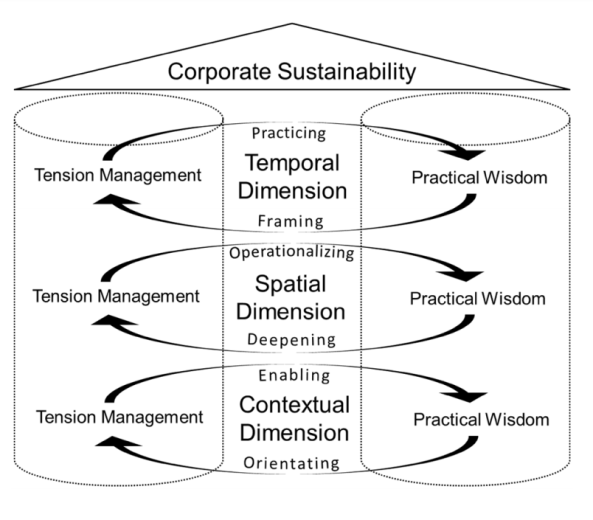
369. Mindfulness (Wamsler in Brossmann 2018)
A framework for systematizing and analyzing the interlinkages between mindfulness and sustainability from the individual to the global scale (Fig. 1). These aspects are culturally shaped and include: (1) subjective well-being; (2) activation of (intrinsic/ non-materialistic) core values; (3) consumption and sustainable behavior; (4) the human–nature connection; (5) equity issues; (6) social activism; and (7) deliberate, flexible, and adaptive responses to climate change. The framework thus supports the understanding that mindfulness can be seen as a key concept to politically sensitizing people and organizations to the consequences of unquestioned structures and power relations.
The mindfulness-sustainability framework can broaden the spatial horizon and help to understand impacts on (distant) communities that might be incongruent with declared values. Understood in this way, mindfulness is no longer a concept that only addresses cognitions and cognitive schemes, but also fosters a sense of appropriate or just behavior (cf. Senghaas-Knobloch 2012). It, therefore, bridges the gap between individual and global scales and wider socio-political structures.

370. Social Sustainability Framework (Design for Social Sustainability: A framework for creating thriving new communities) (Woodcraft 2011)
The Young Foundation has developed a framework containing four elements
that are essential to build new communities that will be successful and sustainable in the long term. These are: amenities and social infrastrucutre; social and cultural life; voice and influence; and space to grow. While all four elements are needed in every new community (alongside good housing, high quality public buildings and spaces, local economic opportunities and design that supports pro-environmental behaviour) social success and sustainability cannot be prescribed in the same way that the standards for green building or environmental sustainability can. A more flexible approach is needed that leaves room to reflect local circumstances and the diverse nature of every community and its individual residents.

371. Value creation in sustainable dynamics model (Stark and Lindow 2017)
The Sustainability Dynamics Model for the first time ever enables the visual and
qualitative capabilities for showing the interdependencies and causal effects of
value creation solutions (e.g. as part of sustainable product development and sustainable manufacturing) with the major systems of the three sustainability dimensions of environment (planet/earth), economy (enterprises) and society (individual). At this point, in time the Sustainability Dynamics Model exists at a foundational level in order to allow high level and principle trade-off discussions and qualitative reasoning.
The Sustainability Dynamics Model (SDM) is an instrument for describing the direct and indirect effects of value creation solutions on the three dimensions of sustainability and vice versa. Since value creation solutions are the key elements they become the central focus of the model. The three dimensions of Sustainable Development (environment, society and economy) actually represent systems of their own and evolve around the value creation solution
The effect of a value creation solution on the dimension systems of sustainability
can be defined as an inside-out effect. Even so, cause and effect vary with different value creation solutions and their impact on sustainability, among other factors. The
Sustainability Dimension Model allows an opposite contemplation, which is called
an outside-in effect.The direct and indirect effects along the Sustainability Dynamics Model can be
defined as inside-out effects and outside-in effects. These effects can be either
observed when the model is read from the inside (sustainable value creation) to the
outside (sustainable dimension systems,) or, vice versa, from the outside the inside.

372. Value Creation Factors treat pillars as dimensions (Bonvoisin 2017)

373. Value mapping tool (in Evans et al. 2017, Yang 2017, Bocken 2014, Yang’s thesis 2015) (including “value uncaptured”)

(Also some interesting looking cards).

374. A tree. just because. It’s really a graphical index to Synovation‘s services, but I like it.
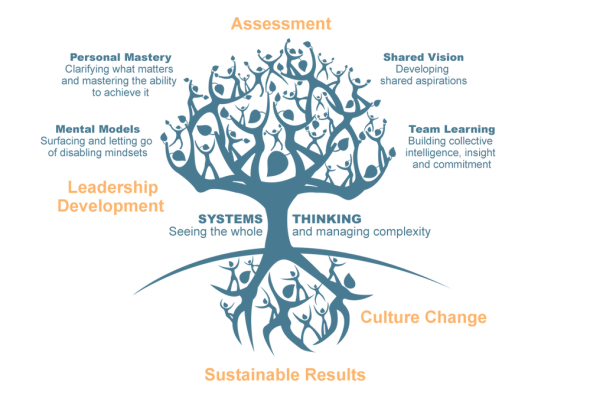
375. Sustainability as part of sociotechnical innovation system of impact and time scales (Gaziulusoy and Brezet 2015)
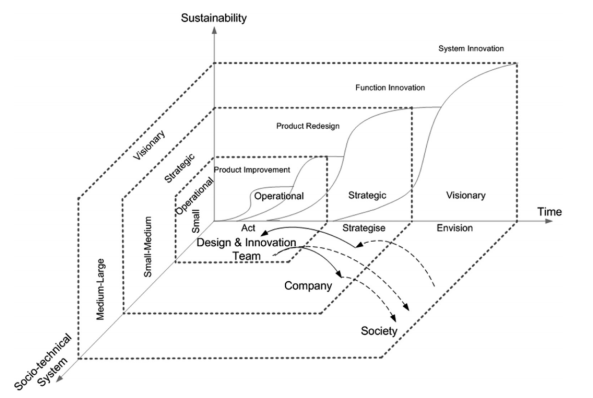
376. Another tree. This time here because of the depth of learning dimension (Valley 2017)

378. City Resilience Index (based on Arup’s Sustainable Project Appraisal Routine).
(text from Adams 2018)
As its circular form suggests, in addition to detailing the “strengths and weaknesses” of a given city, the CRI provides a holistic framework in which certain causal relations across the various indicators can be identified.
While both the SPeAR and the CRI are reflexive tools for assessment, a crucial difference between the two is how each locates a particular temporality in regards to the crisis it aims to address. In the case of the SPeAR model, its role is clearly preventive: it works as a framework to improve upon “business-as-usual” practices of urban design by demonstrating how the ecological footprint of a given scenario can be lowered and energy use mitigated.
Unfortunately, the world surpassed Peak Sustainability in 2005 when the big gamble of staving off climate change with lackluster campaigns of better-than-business-as-usual development was confronted with the very visible effects of climate change.

378. 1000 year sustainability (Mouri 2014)
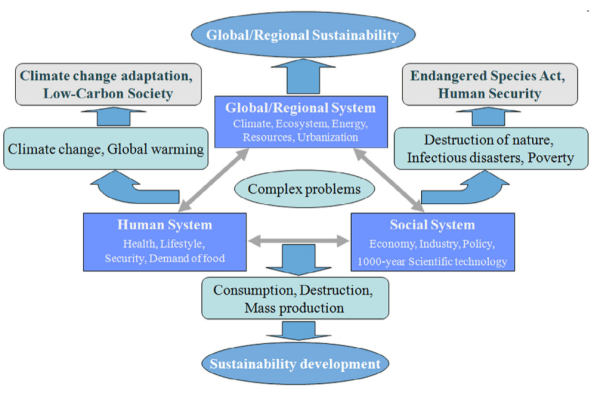
379.1000 year sustainability (2) (Mouri 2014)
Conceptual diagram of a socio-ecological system for millennial-scale sustainability development, which is influenced by spatial and temporal variations, and the relationship between human and economic activity, and environmental issues
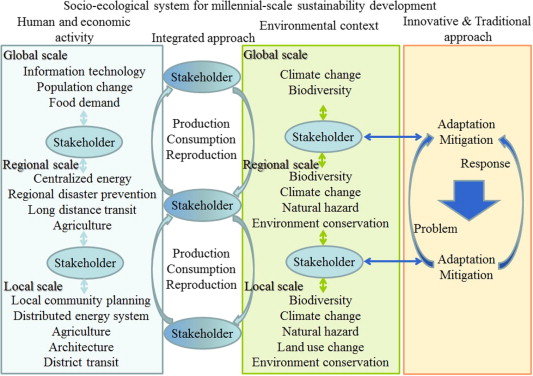
380. Transition to sustainable (water) (Johannessen and Wamsler 2017)
A conceptual model for the process of transition into a more sustainable and hazard-resilient state of urban water. Here, all three levels of resilience need to be taken into account (socioeconomic, external hazards, and social-ecological scale) so that focus on resilience at one level does not compromise the sustainability of another (1-2), where enabling and disabling factors for human agency (3) influence the process of social learning, monitoring, and memory (4). Actors need to navigate uncertainty through prioritization and diversification (5). When thresholds of risk awareness and action capacity are reached (6), measures are put in place, and/or a reorganization occurs (7) and the system makes a transition.
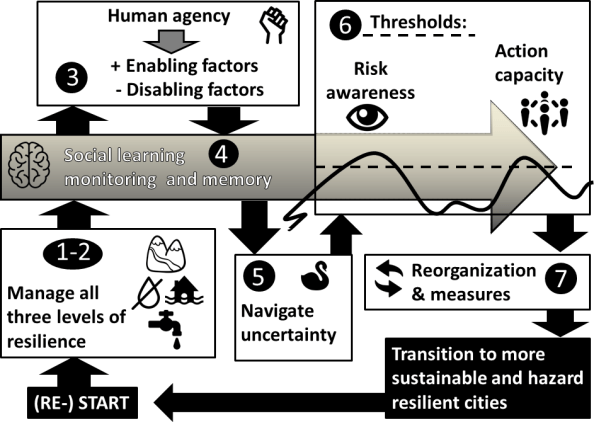
381. Chemical pyramid (Heintz 2014)

382. Typology of business sustainability (Dyllick and Muff 2016)

383. Circle model (Muff 2017)
The real challenge here is the need for an integrated approach of the three key challenges that are need to be overcome when shifting from “inside‐out” to “outside‐in” perspective in order to truly solve the SDGs. It is helpful to consider these three challenges as three different dimensions of engagement as referred to when discussing global responsibility: the “I – we – all of us” (see Figure 2). There is the individual level that addresses the leadership dimension discussed as the third challenge (the “I”), the group level addresses the organizational dimension identified as the second challenge (the “WE”), and the Grand Challenges or issue‐related challenges reflects the larger societal dimension of the first challenge (the “ALL‐OF‐US”). These three dimensions are interconnected and interdependent. Wanting to change one dimensions often implies the necessity to change and amend the others. It is important to work with tools that are designed so that they address not only each challenge individually but enable a further three‐dimensional transformation across all three challenges.

384. Move the dots with your eyes. The circles show the rate of change in dynamic management. No idea what the dots are. (NOAA fisheries and climate change 2019)
The strategy involves first assessing the risk and vulnerability of species, habitat, management approaches and human communities to climate-induced changes. Second, scientists, resource managers, fishing industry members and others evaluate how the existing suite of management measures would perform under different climate and socioeconomic scenarios and identify gaps in institutional capabilities, jurisdictional relationships and funding. And third, they define the optimal combination of management measures and approaches to facilitate adaptation and resilience.
-
Fixed Measures. Developed, implemented and revised over longer timeframes, every ten years or more. Examples include: restrictions on areas where different fishing gear can be used, aggregate harvest limits (catch limits for groups of species), fishing moratoria and marine protected areas.
-
Adaptive Measures. Account for annual or multi-year variability of resources and include quota-based fishery management, rotating closure areas or seasonal closure areas that are adjusted annually or periodically (less than five years).
-
Dynamic Measures. Used during the fishing year to minimize socio-economic consequences with the help of environmental and ecological forecasts and nowcasts that include real-time input from fishermen. These include in-season adjustments to fishing quotas or areas or continuously updated maps of bycatch high-risk areas.

385. Sustainability in Digital Futures (Towards our common digital future. German Advisory Council on Global Change)
Three Dynamics of the Digital Age. The chart shows the positive case of the Dynamics being successfully contained through goals and design. All three Dynamics are already emerging in parallel today, albeit with different levels of intensity, so there is no strict chronological sequence involved. Each Dynamic consists of different subpaths pointing in different directions. The name given to each Dynamic reflects the priorities for action required in each case. The texts beneath the figure give keywords on the potential (upper row) and risks (lower row) of the three Dynamics.

386. Normative compass (Towards our common digital future. German Advisory Council on Global Change )
Normative compass for the Great Transformation towards Sustainability in a digitalized society. The transformation can be achieved by interaction and a balance between the following three dimensions: ‘Sustaining the natural life-support systems’ (N): Comply with planetary guard rails and avoid or solve local environmental problems. ‘Inclusion’ (I): Ensure universal minimum standards for substantive, political and economic inclusion. ‘Eigenart’ (E): Recognize the value of diversity as a resource for successful transformation and as a condition for well-being and quality of life. Up to now, human dignity has been the WBGU’s implicit normative starting point. It cannot be realized without the three compass dimensions, but, as a result of numerous challenges, it is becoming an increasingly explosive issue in the Digital Age. For this reason, the WBGU explicitly names the inviolability of, respect for and the protection of dignity as an aid to orientation in the context of the Transformation towards Sustainability.

(Eigenart translates from German as a peculiarity or individuality, or “individual character”)
387. Theory of Ecologic Transition: a dynamic towards sustainable development (Fernandes 2012)
In effect, by reconciling the elements of profit, innovation and conservation in what is necessarily an unstable equilibrium, reducing assaults on the environment as far as possible (Figure 1), the question of sustainability extends the concept of solidarity. Solidarity is understood here to mean equity, among both the various populations and the individuals of which they are composed, and among the current agents of development and future generations. These thus gain a significant status in the wider issue of discussion on the viability of the Earth, the common homeland of a Humankind that is increasingly considered in its global sense.

388. Mapping approaches (Hopwood 2005)

389. Dynamic sustainable management (Solablity)
In order to remain profitable, companies need to anticipate future trends and risks, both internal (in terms of operational management) and external (in terms of market, regulatory, and technology developments) – and this is what sustainable competitiveness is about. Sustainable management means integrating all the “non-financial” factors that have indirect financial impacts. Sustainable management is not a revolution – it is a natural evolution of management approach and paradigms in an increasingly complex business environment.

390. Sustainable Self (Murray 2011)

391. Wellbeing and hazards (in Tuuli Hirvilammi).

392. Decoupling – impacts and resources (UNEP 2011)

393. Industrial Ecology (University Leiden)
Our department ‘s research aims to support the ecological transformation of society and environment towards sustainability. The research subject is Industrial Ecology in its broadest definition, covering environmental systems analysis, and incorporating the social and economic aspects required for sustainability analysis. System analysis involves the development and application of concepts, methods and models.

394. Sustainable Innovation (Nadi Choucair)

395. Influence diagram of SDGs (Lim et al. 2018)
Influence diagram of the SDGs: illustrating links among the SDGs. Some goals have been split into subgoals to facilitate more precise mapping. Arrows highlight where one goal is likely to have an impact on another goal. The arrowhead represents the goal that is impacted. There is no value attached to the type of impact (i.e., it could be a positive or negative impact). The arrows just illustrate that a relationship exists.

396. Overarching directions (Lim et al. 2018)
Required relationships among the seven overarching directions to orient the SDG system toward the sustainable development end goal: at the core, a stable resilient Earth system (OD3) is the foundation for thriving lives and livelihoods (OD2). This influences and is influenced by a sustainable economy (OD 7). Innovation and education (OD6) are required to facilitate integration across the economic, social, and ecological components of sustainable development and to develop mechanisms to simultaneously advance all three components. This is mediated and regulated by an overarching enabling framework (OD1). To achieve the sustainable development end goal intragenerational (OD4) and intergenerational (OD 5) equity need to be included in the implementation of all other ODs, including OD1. Intragenerational equity (OD4) contributes to future intergenerational equity (OD5).

397. Aligned holistic thinking (DiVito and Bohnsack 2017)
(text via Smart City Innovation Lab 2017)
Researchers…explored the paradox of sustainable entrepreneurs that are oriented on one side towards entrepreneurial growth and on the other side towards sustainable development. Furthermore, they give an insight into sustainability decision making and how entrepreneurial orientation effects sustainability decision tradeoffs.
The singular profile suggests that in making sustainability decision tradeoffs there is a conviction to prioritizing one sustainability dimension above the others. Firms using this kind of singular sustainability decision making are bound by their values and strictly adhere to their principles. Further, they are mission-driven rather than profit-driven and extend theory by showing that sustainable entrepreneurs are more risk taking and proactive individuals and firms. They for example accepted lower profitability or growth compromising the economic dimension. According to the data the focus was on the social dimension like in the following example.
“[We] produce in the Netherlands because I want to be sure about the working conditions. We could produce elsewhere and it would be cheaper [but we don’t want to].”
Flexible decision making accepts greater compromising between the three sustainability dimensions, uses an ordered prioritization and corresponds to high innovativeness and proactiveness.
The holistic profile integrates all three sustainability dimensions, uses an aligned prioritization and corresponds to high proactiveness and risk taking.

398. Singing in the rain. (Ashrafi 2018)

399. Double-coin quadruple helix (Kolehmainen 2016, via Boyes 2018)

400. Transformation Mindset (Mann et al. 2018)


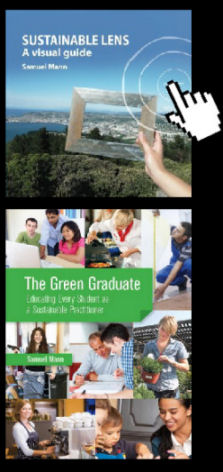
Posted on August 4, 2019
0